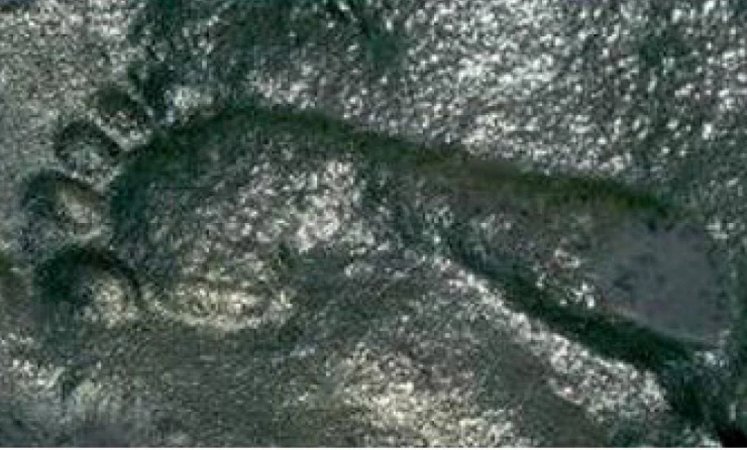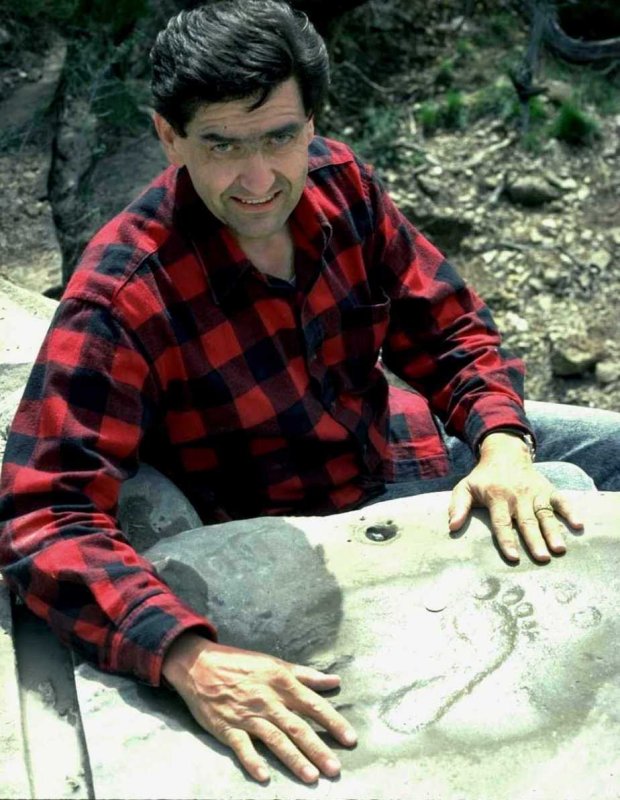Mystery Of The 290-Million-Year-Old Zapata Footprint In New Mexico
Jan Bartek - AncientPages.com - Fossilized footprints are often a subject of heated debates, especially if they are millions of years old and you cannot determine who made them.
In New Mexico, an extraordinary track is made in the mud. It's known as the Zapata footprint, and it is estimated "someone" made it about 290 million years ago.

The strange Zapata footprint is believed to be 290 million years old. Credit: Footprints in stone
Did human-like beings walk the Earth millions of years ago?
Is it a human footprint, or did a long-gone extinct animal make it? What did Earth look like 290 million years ago?
It was a time when the Earth's continents were fused in the supercontinent Pangea. Pangea broke into smaller continents in the Triassic period when dinosaurs first evolved. All plants and animals in those days would be unrecognizable to us.
The Zapata footprint was discovered many years ago by a hunter who informed his friend Don Shockey about the unusual find. Shockey, who knew about archaeology and anthropology, decided to investigate the footprint in the wilderness of New Mexico. He gathered a science team consisting of several experts. Two of the team's participants were Dr. Don Patton and Dr. Carl Baugh.

Stunning View Of What Supercontinent Pangea Looks Like Mapped With Modern Borders - Read More
Dr. Patton was an experienced geologist who had worked in several countries investigating fossils and participated in dinosaur excavations in Colorado, Texas, Wyoming, and Canada.
Dr. Baugh is the discoverer and excavation director of sixteen dinosaurs, including Acrocanthosaurus in Texas and Diplodocus in Colorado.
With such experienced science members, there should be an excellent chance to determine what kind of creature had left the footprint. The investigations should have been easy, but it wasn't due to several obstacles researchers encountered.
Soon after the science team obtained a mining permit to excavate in the area where the track was located, a local armed landowner threatened them for trespassing private land, claiming they were on this private land.

Examination of the Zapata fooprint. Credit: Footprints in stone
Shockey and his team showed the angry man their permission to excavate at the site and explained this was the BLM (Bureau of Land Management) property. Unfortunately, the landowner had a different opinion and told them to leave immediately. The team managed to take some photographs, but researchers were forced to interrupt the documentation, and they left the place in a hurry.
From an archaeological point of view, this was a tragedy because the hunter who had originally reported the discovery "had also reported that he had seen several other human footprints in the rock around the same area and showed Dr. Patton several photographs to validate his story." 1
According to Dr. Patton, the Zapata footprint is exceptionally shallow, making it very difficult to photograph.
So, who made the Zapata footprint? A majority will say humans did not exist millions of years ago. Could the Zapata footprint belong to a bipedal dinosaur? Maybe it can, but as we said at the beginning of this article, this happened during the age of Pangea, and scientists have concluded dinosaurs inhabited the world for some 160 million years. It means the Zapata footprint predates the dinosaurs.
Strange tracks in rocks have been found before, and they often pose a challenge to our historical timelines.
Some years ago, scientists discovered a set of controversial human-like footprints on Crete. These tracks are now putting the theory of human evolution to the test.
"The footprints are about 5.7 million years old from Trachilos in western Crete and have an unmistakably human-like form. It is especially true of the toes. The big toe is similar to our own in shape, size, and position. It is also associated with a distinct 'ball' on the sole, which is never present in apes." 2
Is it possible humans appeared much earlier than previously thought, or did unknown human-like beings leave behind footprints scientists cannot identify?
Written by Jan Bartek - AncientPages.com Staff Writer
Updated on April 4, 2023
Copyright © AncientPages.com All rights reserved. This material may not be published, broadcast, rewritten or redistributed in whole or part without the express written permission of AncientPages.com
Expand for referencesMore From Ancient Pages
-
 Never-Before-Seen Structures Of King Herod’s Magnificent Palace Herodium Unveiled
Archaeology | Dec 11, 2020
Never-Before-Seen Structures Of King Herod’s Magnificent Palace Herodium Unveiled
Archaeology | Dec 11, 2020 -
 18th Century Potter Atmospheric Steam Engine Found In Slovakia
Archaeology | Jul 24, 2020
18th Century Potter Atmospheric Steam Engine Found In Slovakia
Archaeology | Jul 24, 2020 -
 Recently Found ‘Neanderthal Footprints’ In the South Of Spain Could Be 275,000 Years Old
Featured Stories | Dec 1, 2022
Recently Found ‘Neanderthal Footprints’ In the South Of Spain Could Be 275,000 Years Old
Featured Stories | Dec 1, 2022 -
 Mysterious And Frightening Sculptor’s Cave Of The Picts Reconstructed In 3D Model
Archaeology | Dec 10, 2017
Mysterious And Frightening Sculptor’s Cave Of The Picts Reconstructed In 3D Model
Archaeology | Dec 10, 2017 -
 Sweden’s Blue Maiden ‘Blåkulla’ Island – Mythical Place With Dark Secrets Of Witches And Wizardry
Places | Sep 23, 2015
Sweden’s Blue Maiden ‘Blåkulla’ Island – Mythical Place With Dark Secrets Of Witches And Wizardry
Places | Sep 23, 2015 -
 Ancient Graffiti On Sacred Mountain Reveals Secrets Of North Korea
Archaeology | Dec 3, 2021
Ancient Graffiti On Sacred Mountain Reveals Secrets Of North Korea
Archaeology | Dec 3, 2021 -
 Australia’s Submerged Indigenous Sites – New Discoveries And Study
Archaeology | Aug 31, 2021
Australia’s Submerged Indigenous Sites – New Discoveries And Study
Archaeology | Aug 31, 2021 -
 Eugenio De Torralba – Renaissance Magician’s Dangerous Spirit Communications
Featured Stories | May 6, 2019
Eugenio De Torralba – Renaissance Magician’s Dangerous Spirit Communications
Featured Stories | May 6, 2019 -
 Strange Story Of Tecumseh’s Comet, Black Sun Prophecy And New Madrid Earthquakes – The Biggest Earthquakes In American History
Ancient Mysteries | Nov 14, 2018
Strange Story Of Tecumseh’s Comet, Black Sun Prophecy And New Madrid Earthquakes – The Biggest Earthquakes In American History
Ancient Mysteries | Nov 14, 2018 -
 Agni: Hindu God Of Divine Illumination And One Of The Three Supreme Deities Of Vedic Lore
Featured Stories | May 3, 2018
Agni: Hindu God Of Divine Illumination And One Of The Three Supreme Deities Of Vedic Lore
Featured Stories | May 3, 2018 -
 Bizarre Towering Pillars Of Externsteine: Myths, Legends And Sacred Rituals From Times Long Gone
Civilizations | Jan 7, 2017
Bizarre Towering Pillars Of Externsteine: Myths, Legends And Sacred Rituals From Times Long Gone
Civilizations | Jan 7, 2017 -
 Secrets Of The Famous Hellenistic-Era Kyrenia Shipwreck Revealed
Archaeology | Jun 28, 2024
Secrets Of The Famous Hellenistic-Era Kyrenia Shipwreck Revealed
Archaeology | Jun 28, 2024 -
 Amanitore – Nubian Warrior Queen And Her Pyramids
Historical Figures | Aug 13, 2018
Amanitore – Nubian Warrior Queen And Her Pyramids
Historical Figures | Aug 13, 2018 -
 Forgotten Ancient Empire That Extended Far Beyond America To Iceland And Its Mysterious Inscriptions
Ancient Mysteries | May 6, 2021
Forgotten Ancient Empire That Extended Far Beyond America To Iceland And Its Mysterious Inscriptions
Ancient Mysteries | May 6, 2021 -
 The Face Of The Amarakarei – Remarkable Enormous Face Caved Into Stone Cliffs In Peru
Places | Nov 20, 2015
The Face Of The Amarakarei – Remarkable Enormous Face Caved Into Stone Cliffs In Peru
Places | Nov 20, 2015 -
 On This Day In History: Count Leo Tolstoy Was Censored – On Feb 20, 1901
News | Feb 20, 2017
On This Day In History: Count Leo Tolstoy Was Censored – On Feb 20, 1901
News | Feb 20, 2017 -
 On This Day In History: Vlad III Dracula Regained Throne Of Wallachia For The Third Time – On Nov 26, 1476
News | Nov 26, 2016
On This Day In History: Vlad III Dracula Regained Throne Of Wallachia For The Third Time – On Nov 26, 1476
News | Nov 26, 2016 -
 Sedna: Inuit Goddess Sacrificed By Selfish Father Fearing For His Own Life
Featured Stories | Jan 7, 2020
Sedna: Inuit Goddess Sacrificed By Selfish Father Fearing For His Own Life
Featured Stories | Jan 7, 2020 -
 Once Looted Nearly 1,000-Year-Old Maya Text Is Authentic – Mexican Experts Say
Archaeology | Sep 1, 2018
Once Looted Nearly 1,000-Year-Old Maya Text Is Authentic – Mexican Experts Say
Archaeology | Sep 1, 2018 -
 Bronze Age Metal Cauldrons Show What Ancient People Ate
Archaeology | Aug 19, 2023
Bronze Age Metal Cauldrons Show What Ancient People Ate
Archaeology | Aug 19, 2023
